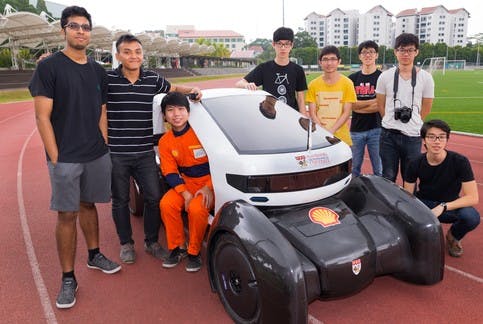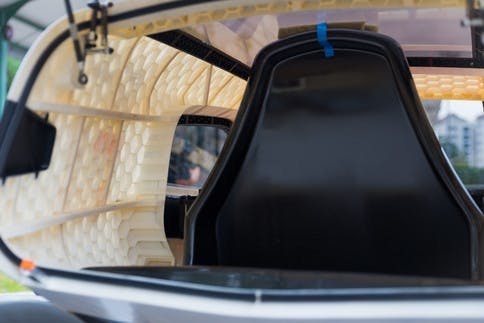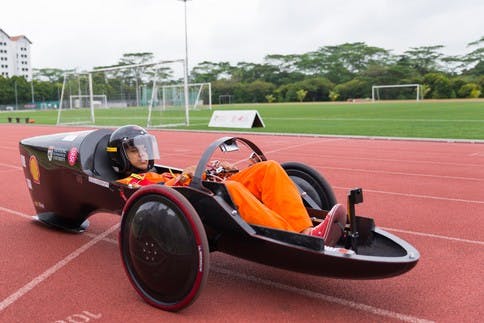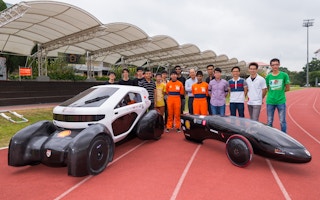Students from Nanyang Technological University (NTU) on Monday unveiled Singapore’s first 3D-printed solar electric car, giving a glimpse into what cars of the future could look like.
To continue reading, subscribe to Eco‑Business.
There's something for everyone. We offer a range of subscription plans.
- Access our stories and receive our Insights Weekly newsletter with the free EB Member plan.
- Unlock unlimited access to our content and archive with EB Circle.
- Publish your content with EB Premium.
The car, known as the NTU Venture 8 (NV8) was designed and built by NTU undergraduates, and will compete in the Urban Concept category at oil giant Shell’s annual Eco-marathon Asia at the end of the month.
Ng Heong Wah, an NTU associate professor who mentored the students, said that the students opted to pursue “disruptive innovations” rather than adapt previous designs.
“The 3D printed car body was pushing existing technology to the limits”, he said, adding that the electric car is “Singapore’s first and probably Asia’s first 3D-printed concept car”.

The student team behind the NV 8 - Singapore’s first Urban Concept car with a 3D-printed body shell
The NV8’s body shell consists of 150 parts, which were made on various 3D printers in NTU, partner institutions, and sponsor companies.
These included 3D printer manufacturers Stratasys and research centre Singapore-MIT Alliance for Research and Technology (SMART).

The NV8’s unique honeycomb design, which provides structural strength while keeping the weight to a minimum.
It took students three months to print and assemble the car’s chassis, which features a honeycomb structure that makes it lightweight, thin, and strong.
Weighing a mere 120 kilogrammes - compared to conventional car weights that average more than 1,000kg - the electric vehicle is partially powered by handmade curved silicon solar cells mounted on to the car and can reach a top speed of 60km/h. These were also developed by the students.
In addition to the urban NV8, NTU students also unveiled the NV9, a three-wheeled racer with the unique ability to navigate sharp corners at high speeds, thanks to a tilting function inspired by motorcycle racing.

The NV9, an electric racecar whose aerodynamic design is inspired by motorcycles. The car has the ability to tilt, which allows it to navigate corners at high speeds.
The car, also mounted with solar cells, will compete in the Shell Eco-marathon’s Prototype category, which showcases futuristic prototypes that maximise fuel efficiency through innovative design.
Shell’s Eco-marathon - held in Manila, Philippines, this year - is an annual event which challenges students to design, build and drive a vehicle that can travel the furthest distance using the least amount of energy.
Winston Tan, a final-year electrical and electronic engineering student who headed the NV9 project, said that the team “aimed for it to be as streamlined as possible”.
“The resulting design looks like a fusion between a F1 racecar and a glider plane,” he added.
The two NTU teams consist of 16 students, who spent a year building the cars at a facility called the Innovation Lab in the university’s School of Mechanical and Aerospace Engineering.
Last June, the university launched a S$30 million Additive Manufacturing Centre (NAMC) to support research and development in 3D printing – a rapidly-growing industry tipped to revolutionise the way products are manufactured.
In December, NAMC was subsumed under the newly established Singapore Centre for 3D printing, which was set up with S$113 million of funding from the university, government, and industry to drive research of 3D printing applications in the marine and offshore, building and construction, and aerospace and defence sectors, among others.










